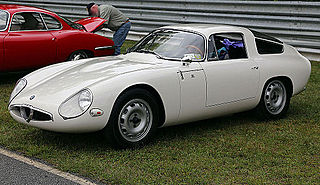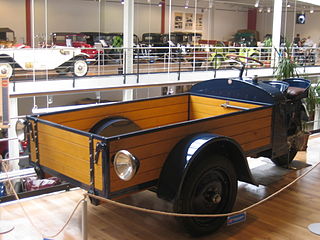
Tatra is a Czech vehicle manufacturer from Kopřivnice. It is owned by the TATRA TRUCKS a.s. company, and it is the third oldest company in the world producing motor vehicles with an unbroken history. The company was founded in 1850 as Ignatz Schustala & Cie. In 1890 the company became a joint-stock company and was renamed the Nesselsdorfer Wagenbau-Fabriksgesellschaft. In 1897, the Nesselsdorfer Wagenbau-Fabriksgesellschaft produced the Präsident, which was the first factory-produced automobile with a petrol engine to be made in Central and Eastern Europe. In 1918, the company was renamed Kopřivnická vozovka a.s., and in 1919 it changed from the Nesselsdorfer marque to the Tatra badge, named after the nearby Tatra Mountains on the Czechoslovak-Polish border.

Dino was a marque best known for mid-engined, rear-drive sports cars produced by Ferrari from 1957 to 1976. The marque came into existence in late 1956 with a front-engined Formula Two racer powered by a brand new Dino V6 engine. The name Dino was used for some models with engines smaller than 12 cylinders, it was an attempt by the company to offer a relatively low-cost sports car. The Ferrari name remained reserved for its premium V12 and flat-12 models until 1976, when "Dino" was retired in favour of full Ferrari branding.

ASA was an Italian automobile manufacturer active from 1961 to 1969, who is known for manufacturing the ASA 1000 GT. This car was developed by Ferrari engineers in the late 1950s as a less expensive, compact alternative to existing Ferrari GT cars. ASA used inline-four and straight-six engines derived from the "250" 3-litre V12 designed by Gioacchino Colombo. The chassis was developed by Giotto Bizzarrini and was derived from the tubular frame chassis of the 250 GTO.

The Ferrari250 Testa Rossa, or 250 TR, is a racing sports car built by Ferrari from 1957 to 1961. It was introduced at the end of the 1957 racing season in response to rule changes that enforced a maximum engine displacement of 3 litres for the 24 Hours of Le Mans and World Sports Car Championship races. The 250 TR was closely related to earlier Ferrari sports cars, sharing many key components with other 250 models and the 500 TR.

The Porsche 908 was a racing car from Porsche, introduced in 1968 to continue the Porsche 906-Porsche 910-Porsche 907 series of models designed by Helmuth Bott (chassis) and Hans Mezger (engine) under the leadership of racing chief Ferdinand Piëch.

The Maserati Tipo 60/61 are a series of sports racing cars produced between 1959 and 1961 by Italian automobile manufacturer Maserati for privateers racing in sports car events including the 24 Hours of Le Mans in the 2-litre and 3-litre racing category. It used an intricate tubular space frame chassis, containing about 200 chro-moly steel tubes welded together, arranged triangular formation at high stress areas of the chassis, hence the nickname "Birdcage". This method of construction provided a more rigid and, at the same time, lighter chassis than other racing cars of the time.

The TatraT813 was a truck produced in Czechoslovakia by the Tatra company. It was produced from 1967 to 1982. The basic representative of this series was a military version of the 8×8 Kolos (Colossus), which was able to pull trailers up to a total weight of 100 tons. Tatra also produced a civilian version in either 6×6 or 4×4. After fifteen years of production, 11,751 vehicles were built in all modifications. Many units were exported to the USSR, East Germany, Romania and India.

The Tatra 148 was a truck produced in Czechoslovakia by the Tatra company.

The Alfa Romeo Giulia TZ was a sports car and racing car manufactured by Alfa Romeo from 1963 to 1967. It replaced the Giulietta SZ. In 2011, the name was reduced from Giulia TZ to TZ in the new TZ3 model.

The ALFA 24 HP is a 4.1-litre four-cylinder passenger car, the first model produced by Italian car manufacturer ALFA, which in 1919 would become Alfa Romeo. It was introduced in 1910, the year ALFA was founded, and produced until 1914 in ALFA's Portello factory near Milan. The model's name comes from its tax horsepower rating, then frequently used as vehicle designation.

The Tatra 111 was a truck produced in Czechoslovakia by the Tatra company.

The Tatra 138 was a truck produced in Czechoslovakia by the Tatra company. The immediate successor to the Tatra 111, the model introduced a number of new features while continuing the evolution of Tatra concept. The truck was produced from 1959 to 1971.

The Tatra 30 is an automobile formerly made by the Czech manufacturer Tatra. It was manufactured between 1926 and 1928. From 1928 to 1931 the car was fitted with a newer engine and is therefore called the Tatra 30/52.

The Tatra 26 is a vintage 6x4 automobile produced by the Czech manufacturer Tatra in the late 1920s and early 1930s. It was developed on the basis of the T 12. However, tests showed that the engine from T 12 did not have enough power, and it was replaced by the Tatra 30 engine. The car had extreme off-road abilities - reportedly it was even able to climb staircases.

The Tatra 70 is a Czechoslovak luxury car that was made by Tatra at Kopřivnice from 1931 to 1937. It succeeded the Tatra 31.

The Tatra 49 is a model of vintage three-wheeled motor vehicle made by Czech manufacturer Tatra.

The Tatra 13 is a vintage truck made by Czech manufacturer Tatra. It was manufactured between 1924 and 1933.

The original Škoda Superb is a full size luxury car that was made by the Czechoslovak car manufacturer ASAP, later AZNP from 1934 to 1949. It was the company's first car with a V8 engine and all-wheel drive.

The Porsche 911 is a two-door 2+2 high performance rear-engined sports car introduced in September 1964 by Porsche AG of Stuttgart, Germany. It has a rear-mounted flat-six engine and originally a torsion bar suspension. The car has been continuously enhanced through the years but the basic concept has remained unchanged. The engines were air-cooled until the introduction of the 996 series in 1998.

The Ferrari SP was a series of Italian sports prototype racing cars produced by Ferrari during the early 1960s. All featured a rear mid-engine layout, a first for a Ferrari sports car. Major racing accolades include the 1962 European Hill Climb Championship, two overall Targa Florio victories, in 1961 and 1962, and "1962 Coupe des Sports" title.
































